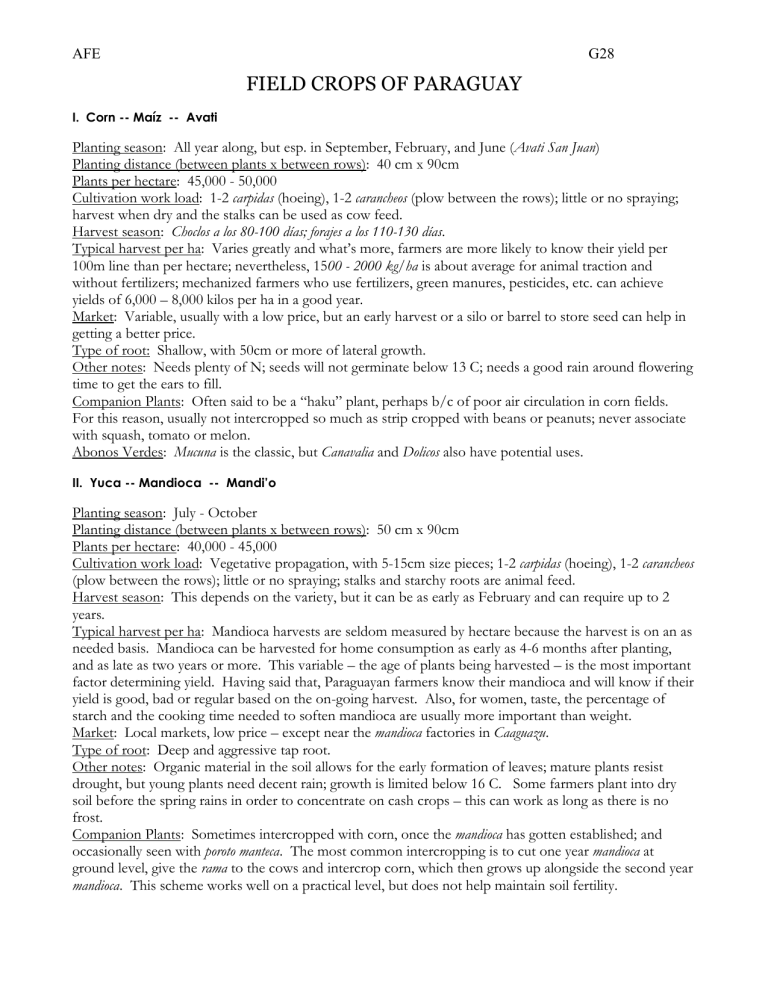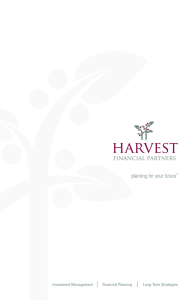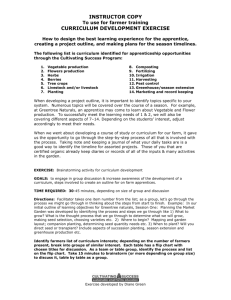
AFE G28 FIELD CROPS OF PARAGUAY I. Corn -- Maíz -- Avati Planting season: All year along, but esp. in September, February, and June (Avati San Juan) Planting distance (between plants x between rows): 40 cm x 90cm Plants per hectare: 45,000 - 50,000 Cultivation work load: 1-2 carpidas (hoeing), 1-2 carancheos (plow between the rows); little or no spraying; harvest when dry and the stalks can be used as cow feed. Harvest season: Choclos a los 80-100 días; forajes a los 110-130 días. Typical harvest per ha: Varies greatly and what’s more, farmers are more likely to know their yield per 100m line than per hectare; nevertheless, 1500 - 2000 kg/ha is about average for animal traction and without fertilizers; mechanized farmers who use fertilizers, green manures, pesticides, etc. can achieve yields of 6,000 – 8,000 kilos per ha in a good year. Market: Variable, usually with a low price, but an early harvest or a silo or barrel to store seed can help in getting a better price. Type of root: Shallow, with 50cm or more of lateral growth. Other notes: Needs plenty of N; seeds will not germinate below 13 C; needs a good rain around flowering time to get the ears to fill. Companion Plants: Often said to be a “haku” plant, perhaps b/c of poor air circulation in corn fields. For this reason, usually not intercropped so much as strip cropped with beans or peanuts; never associate with squash, tomato or melon. Abonos Verdes: Mucuna is the classic, but Canavalia and Dolicos also have potential uses. II. Yuca -- Mandioca -- Mandi’o Planting season: July - October Planting distance (between plants x between rows): 50 cm x 90cm Plants per hectare: 40,000 - 45,000 Cultivation work load: Vegetative propagation, with 5-15cm size pieces; 1-2 carpidas (hoeing), 1-2 carancheos (plow between the rows); little or no spraying; stalks and starchy roots are animal feed. Harvest season: This depends on the variety, but it can be as early as February and can require up to 2 years. Typical harvest per ha: Mandioca harvests are seldom measured by hectare because the harvest is on an as needed basis. Mandioca can be harvested for home consumption as early as 4-6 months after planting, and as late as two years or more. This variable – the age of plants being harvested – is the most important factor determining yield. Having said that, Paraguayan farmers know their mandioca and will know if their yield is good, bad or regular based on the on-going harvest. Also, for women, taste, the percentage of starch and the cooking time needed to soften mandioca are usually more important than weight. Market: Local markets, low price – except near the mandioca factories in Caaguazu. Type of root: Deep and aggressive tap root. Other notes: Organic material in the soil allows for the early formation of leaves; mature plants resist drought, but young plants need decent rain; growth is limited below 16 C. Some farmers plant into dry soil before the spring rains in order to concentrate on cash crops – this can work as long as there is no frost. Companion Plants: Sometimes intercropped with corn, once the mandioca has gotten established; and occasionally seen with poroto manteca. The most common intercropping is to cut one year mandioca at ground level, give the rama to the cows and intercrop corn, which then grows up alongside the second year mandioca. This scheme works well on a practical level, but does not help maintain soil fertility. AFE G28 Abonos Verdes: Manteca is the most logical, since it can climb the mandioca, and you will often see Kumanda Yvyra' i with mandioca; Canavalia is another nice idea, either between rows or in empty spaces where the mandioca either did not come up or has been harvested. III. Cotton -- Algódon -- Mandyju Planting season: September - October Planting distance (between plants x between rows): 30 cm x 90cm Plants per hectare: 55,000 - 60,000 Cultivation work load: Re-seed in 15 days, thin in October/November, 3 carpidas, and several carancheos, Sometimes chemical fertilizer, and plenty of sprayings; boll weevil (picudo) traps are also available. Harvest season: February - April Typical harvest per ha: Varies greatly; as a guide, you might say: 700 - 1200 kg/ha sin fertilización, 15002000 kg/ha con fertilización. It takes about 110 - 180 cotton bolls to harvest one kilo of fiber. Market: It is a sure sell, but the price stinks. Commercialization with a comité can improve the price. Type of root: Tap root is 25 - 100 cm, according to soil conditions, and the lateral root is 25-50cm. Root growth can be limited if there is too much water in the soil, or too little, or if there is a hard pan, or nematodes. Other notes: Needs plenty of nutrients in the soil, intolerant of shade or acidy soils; medium to low rainfall needs and cotton must be dry before it can be harvested (not for early risers). Flowers need a high temperature and full sun to set capsules and the size and quantity of capsules depends on the variety and, of course, growth conditions. Nutrients: Maximum use of nutrients occurs between the 3rd and 8th weeks of growth, that is, before the capsules have formed. Companion Plants: This is not done – by tradition and b/c of the sprayings required for cotton. Abonos Verdes: It is quite rare to see abonos verdes associated with algódon, but mucuna, crotelaria (de verano) or avena negra (invierno) can be used as part of a crop rotation; many books talk of cotton plantings with kumanda yvyra’i or leuacaena in strip cropping, but this would be tricky to manage and is seldom seen outside of experimental fields. IV. Bean -- Poroto -- Kumanda Planting season: August – December Planting distance (between plants x between rows): 30 cm x 90cm Plants per hectare: 55,000 - 60,000 Cultivation work load: One good carpida in the first 30 dias, then 1-2 more carpidas, and several carancheos; Sometimes grown with chemical fertilizers and sprayings, but this can harm pollinating agents. Harvest season: December - May Market: You can usually sell beans, but the price falls around peak harvest time. Harvesting is slow and tedious and for this reason, it is rare to see lots of beans planted for market. Type of root: Tap root 25 - 80 cm, according to soil conditions, and lateral roots that run a lot. Other notes: There are many leaf diseases for beans, so it is not wise to harvest when wet; there are also several small worms that thrive in the pods, but these are not usually significant if the beans are for home consumption. Companion Plants: Most often seen with corn – and rightly so. Abonos Verdes: Many summer abonos verdes are in the bean family, so you have to be careful to rotate; avena negra is excellent right before poroto. V. Peanut -- Maní -- Manduvi Planting season: August - October AFE G28 Planting distance (between plants x between rows): 20 cm x 80cm Plants per hectare: 55,000 - 60,000 Cultivation work load: Dos carpidas y dos carancheos; little or no spraying (Sometimes there are problems with spider mites, “acaros”); maní needs to be hilled up once the flowers have been polonized – these flowers then enter the soil and form the peanuts. Harvest season: Depends on the variety, 4-6 months. Typical harvest per ha: 1500 – 2000 kg/ha Market: Local markets, but not usually a high price. Type of root: The tap root prefers soft, sandy soil. Other notes: Do not lime the soil for peanuts; if you get a lot of empty shells (“pops”), this is often due to a lack of calcium in the soil. Companion Plants: It is unusual to see associations with mani. Abonos Verdes: You can use Canavalia together with maní, or avena negra in rotation. VI. Sweet Potato -- Batata -- Jety Planting season: July – November; can also be planted in the fall, but will die if there is a deep frost. Planting distance (between plants x between rows): 35 cm x 120cm. For large plantations, it is necessary to raise seeds in an almacigo; 100-150 m2 of almacigo space will yield enough “seed” for one hectare of batata. Plants per hectare: 25,000 - 33,000 Cultivation work load: Vegetative propagation, with 20-30cm pieces of the stem; plant at a depth of 1015cm, raise the rows to a height of 25-40cm with the first hilling up (aporcar); batata needs one carpida (hoeing) and one carancheo (plow between the rows); little or no spraying. Harvest season: Depends on the variety, but can be as early as two months or as late as eight (longer than this and the roots begin to rot underground). Typical harvest per ha: 20 - 22 tons per ha Market: There is a market for batata when mandioca gets scarce (Sept. – Dec.). Type of root: The tap root is aggressive and deep. Other notes: Does well in old soil, but not too old; there are many varieties. Companion Plants: Batata can be intercropped with corn or mandioca because it runs along the ground. Abonos Verdes: It is difficult to use abono verde with batata, because its growing pattern is fairly aggressive, but in theory it could be planted with kumanda yvyra’i or croterlaria. VII. Peas -- Arveja Planting season: March - July Planting distance (between plants x between rows): 15 cm x 60cm Plants per hectare: Seldom will you see a full hectare of arveja in Paraguay (3 kg. of seeds should fill 10 lines of 100m) Cultivation work load: 1-2 carpidas and 1-2 carancheos; little or no spraying; the vines are excellent forage. Harvest season: A los 70-80 días Market: Local market, but an excellent option -- especially as green peas (“peky”). Typical harvest: You can expect to harvest 15-20 kilos de arveja seca for each kilo of seed planted. Other notes: A dry winter will limit fruit production, so it is best to get an early start – March, April or May – if watering is not an option. Companion Plants: Sometimes associated with corn. Abonos Verdes: Arveja is a legume and so if you allow the vine to decompose in the field, it could be considered an abono verde. AFE G28 VIII. Onion -- Cebolla -- Sevoi Planting season: March - May Planting distance (between plants x between rows): First plant in an almácigo, then move to the field after 30-40 days; plant 5-7 seedlings per meter and 2-3 lines per meter. Plants per hectare: 400 grams of seeds should yield enough seedlings for a ¼ ha. Cultivation work load: Transplant after 5-6 weeks or when the seedlings have a height of 12-15cm and the width of a small twig – when the ground is damp but not soaked; requires two carpidas and little or no spraying. Harvest season: When the stems dry and tip over and the bulbs emerge from the soil; dry well before storing. Market: Excellent market potential if well dried. Companion Plants: Tough to associate with anything except on a small scale in the garden. Abonos Verdes: You can use avena negra in rotation with onion. IX. Sugar Cane – Caña de Azúcar – Takuare’e Planting season: Varies geographically – usually in the spring Planting distance (between plants x between rows): 120-150 cm between surcos, and you need 6.5 - 9 tons per ha. The seed cuttings are distributed in double rows and make sure that each cutting has at least 2 or 3 sprouts. Cultivation work load: First carpida a los 25 a 30 días and so on, depending on the need. Harvest season: March – December; after the first year sugar cane can stay put in the same field for many years (4-6 is best, more than that and yields go down). In some areas of Paraguay sugar cane is harvested twice – it seems to depend on the buying preferences and schedule of the closest factory. Abonos Verdes: You can use canavalia as an abono verde between the rows of caña de azúcar. X. Sunflower -- Girasol Planting season: July - September Planting distance (between plants x between rows): about 5 seed drops per meter and 70-80cm between rows; Plant deeper in sandy soils. Plants per hectare: 50,000 - 55,000 Cultivation work load: 1-2 carpidas (hoeing), 1-2 carancheos (plow between the rows); little or no spraying; harvest when dry and beat or shake the seeds out. Harvest season: 140-160 days alter planting. Typical harvest per ha: 1500- 2500 kg/ha Market: In the northern and eastern parts of eastern Paraguay, sunflower seeds can be sold where they make animal feed – usually where the Mennonites are. It is also refined for oil. Type of root: Shallow, with 50cm or more of lateral growth. Does not do well in poorly drained soils. Other notes: Sunflower is most commonly seen as a mechanized farming crop and an efficient harvest is quite challenging without machinery. Excellent source of digestible protein for humans and livestock. Companion Plants: Often said to be a “haku” plant, perhaps b/c of an aleopathic substance in the roots. For this reason, usually not intercropped so much as strip cropped with beans or soy. Abonos Verdes: Girasol is itself often grown as an abono verde and would benefit from following a nitrogen fixing summer abono verde.

